Printmaking Techniques
 A brief explanation of printmaking techniques
A brief explanation of printmaking techniques
Printmaking has many different kinds of “voices” to choose from. There are many different types of marks and effects to pull from the bag of tricks– tightly controlled lines to the more random lift ground effects. Some marks look like other mediums, such as pen and ink, and others are unique to the plate making and printing process. Some images are suited to the graphic boldness of linoleum, and some are suited to the textures of collagraph or soft ground etching.
Each plate travels on a little journey as you layer on the effects; the transformations that happen often take you by surprise. As you journey, you can take proofs of the different states along the way, to see where you are, and to preserve a record of where you have been.
Limited Edition Fine Art Multiples
All these printmaking techniques are limited edition, fine art multiples. There is a matrix, or plate that is created to take impressions from. They are not mechanical or digital reproductions. Each print is inked and wiped by hand, with the artist directly involved in printing each one. They are printed on 100% archival cotton rag paper. An edition is generally all on the same colored ink and paper. EV signifies that the edition varies, as is often the case with collagraph. My editions are small, rarely exceeding 35 total.
Intaglio Etching
Etching is a printmaking process that uses acid to bite grooves into a plate, which will then hold ink. First you coat the copper or zinc plate with an acid-resistant ground. Then you draw or break through the ground, exposing the metal to the etching action of the acid. Stronger lines are made through longer times in the acid.
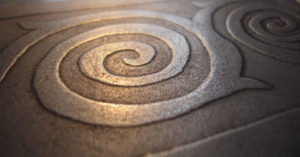
There are many approaches to creating a plate. There are two types of acid-resistant ground. Hard Ground will give you clear sharp lines. Soft Ground is waxier and can be used to create softer pencil-like lines or transfer textures. Aquatint, a layer of fine rosin dust, is used to create tones. Scraping and burnishing can be used to remove or lighten areas and dial in the exact tones desired– the “push and pull”.
To print the plate, ink is applied to the whole image and then wiped off the upper surfaces, leaving just the ink in the lines. A high-pressure press is used to transfer the ink onto dampened cotton rag paper. You repeat the inking and wiping steps for each print to make an edition of prints. This process is known as ‘intaglio”, which is printing from the lower levels.
Applying Color
When I colorize an image I often use a technique called “A la poupee”. This is a way of applying color to certain areas on a plate. Each color is applied one by one with a small chip or swab, pushing the ink towards the shape as you wipe the excess off the surface. Then you add the next color, wiping most of it before moving on, and so on through all the colors. Then one final wipe creates even tones. Another way to do color prints is to create two or more plates that combine to make more colors in several passes.
 Drypoint
Drypoint
Drypoint does not use the acid process. The lines are scratched in the plate directly with a sharp stylus. Each line throws up a burr which is what catches the ink. The noticeable quality of drypoint is the fuzzy line and rich darks that are created by scratching, then scraping away, and scratching some more to build up lines. Mezzotint is a cousin to drypoint, where you raise little burrs all over the whole plate to make a velvety black, then burnish highlights, drawing it out of the darkness.
Relief printing
Woodcut and linoleum are both relief printing techniques, and the ink is rolled on the upper surface. The effect of carving away the white usually creates a very strong, graphic design. Although simple in concept there is still the challenge of bold design, negative/positive space, and working in reverse. One advantage is that relief prints can be printed without a press.
Collagraph
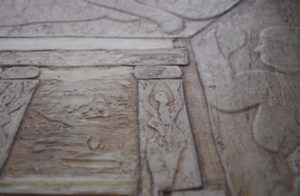 Collagraph is a method of making a plate by building up rather than etching levels. It is built upon a base of mat board using glued layers of textured material, and thin paper such as Bristol board. You can also use modeling paste to create textures. The finished plate, or matrix, is finally coated in Acrylic gel medium to seal it for printing and clean up. Collagraphs can be inked, wiped, and printed from the lower level ink, or the upper surfaces can be rolled with color or a combination of both.
Collagraph is a method of making a plate by building up rather than etching levels. It is built upon a base of mat board using glued layers of textured material, and thin paper such as Bristol board. You can also use modeling paste to create textures. The finished plate, or matrix, is finally coated in Acrylic gel medium to seal it for printing and clean up. Collagraphs can be inked, wiped, and printed from the lower level ink, or the upper surfaces can be rolled with color or a combination of both.
Monotype
Monotype is working directly with ink on a piece of Plexiglas. There is no repeatable image on the plate, and so they are unique impressions. Working reductively, you can roll the whole plate in one solid color, and remove it with rags and sticks. Working additively is applying the ink with rollers, brushes, stencils, and textured materials You can add layers and reprint the “ghost”, or the remnants of the first impression. There are numerous ways of approaching monotype and most artists use a combination of techniques.

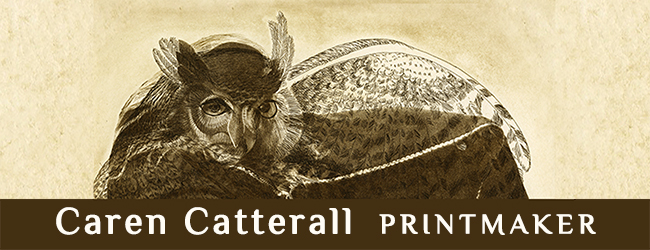
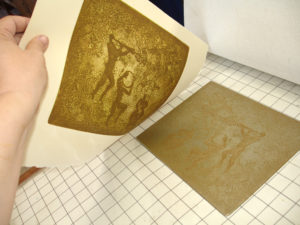 A brief explanation of printmaking techniques
A brief explanation of printmaking techniques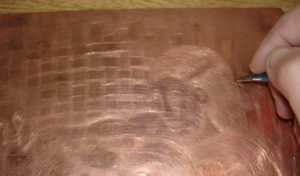 Drypoint
Drypoint